Xianqiao Wang
A Multi-Agent Framework Integrating Large Language Models and Generative AI for Accelerated Metamaterial Design
Mar 25, 2025Abstract:Metamaterials, renowned for their exceptional mechanical, electromagnetic, and thermal properties, hold transformative potential across diverse applications, yet their design remains constrained by labor-intensive trial-and-error methods and limited data interoperability. Here, we introduce CrossMatAgent--a novel multi-agent framework that synergistically integrates large language models with state-of-the-art generative AI to revolutionize metamaterial design. By orchestrating a hierarchical team of agents--each specializing in tasks such as pattern analysis, architectural synthesis, prompt engineering, and supervisory feedback--our system leverages the multimodal reasoning of GPT-4o alongside the generative precision of DALL-E 3 and a fine-tuned Stable Diffusion XL model. This integrated approach automates data augmentation, enhances design fidelity, and produces simulation- and 3D printing-ready metamaterial patterns. Comprehensive evaluations, including CLIP-based alignment, SHAP interpretability analyses, and mechanical simulations under varied load conditions, demonstrate the framework's ability to generate diverse, reproducible, and application-ready designs. CrossMatAgent thus establishes a scalable, AI-driven paradigm that bridges the gap between conceptual innovation and practical realization, paving the way for accelerated metamaterial development.
Physics-informed deep learning for infectious disease forecasting
Jan 16, 2025



Abstract:Accurate forecasting of contagious illnesses has become increasingly important to public health policymaking, and better prediction could prevent the loss of millions of lives. To better prepare for future pandemics, it is essential to improve forecasting methods and capabilities. In this work, we propose a new infectious disease forecasting model based on physics-informed neural networks (PINNs), an emerging area of scientific machine learning. The proposed PINN model incorporates dynamical systems representations of disease transmission into the loss function, thereby assimilating epidemiological theory and data using neural networks (NNs). Our approach is designed to prevent model overfitting, which often occurs when training deep learning models with observation data alone. In addition, we employ an additional sub-network to account for mobility, vaccination, and other covariates that influence the transmission rate, a key parameter in the compartment model. To demonstrate the capability of the proposed model, we examine the performance of the model using state-level COVID-19 data in California. Our simulation results show that predictions of PINN model on the number of cases, deaths, and hospitalizations are consistent with existing benchmarks. In particular, the PINN model outperforms the basic NN model and naive baseline forecast. We also show that the performance of the PINN model is comparable to a sophisticated Gaussian infection state space with time dependence (GISST) forecasting model that integrates the compartment model with a data observation model and a regression model for inferring parameters in the compartment model. Nonetheless, the PINN model offers a simpler structure and is easier to implement. Our results show that the proposed forecaster could potentially serve as a new computational tool to enhance the current capacity of infectious disease forecasting.
Large Language Models for Bioinformatics
Jan 10, 2025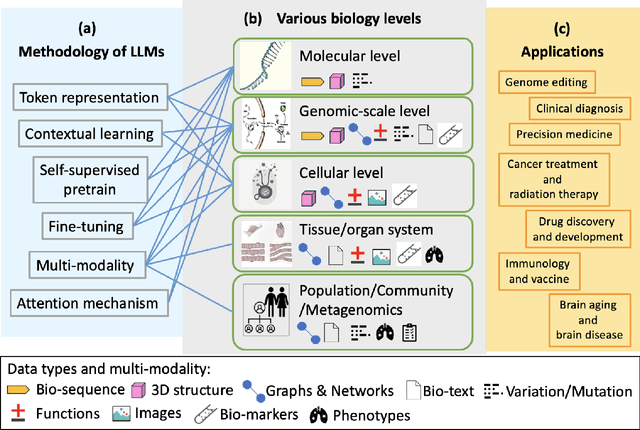
Abstract:With the rapid advancements in large language model (LLM) technology and the emergence of bioinformatics-specific language models (BioLMs), there is a growing need for a comprehensive analysis of the current landscape, computational characteristics, and diverse applications. This survey aims to address this need by providing a thorough review of BioLMs, focusing on their evolution, classification, and distinguishing features, alongside a detailed examination of training methodologies, datasets, and evaluation frameworks. We explore the wide-ranging applications of BioLMs in critical areas such as disease diagnosis, drug discovery, and vaccine development, highlighting their impact and transformative potential in bioinformatics. We identify key challenges and limitations inherent in BioLMs, including data privacy and security concerns, interpretability issues, biases in training data and model outputs, and domain adaptation complexities. Finally, we highlight emerging trends and future directions, offering valuable insights to guide researchers and clinicians toward advancing BioLMs for increasingly sophisticated biological and clinical applications.
Large Language Models for Manufacturing
Oct 28, 2024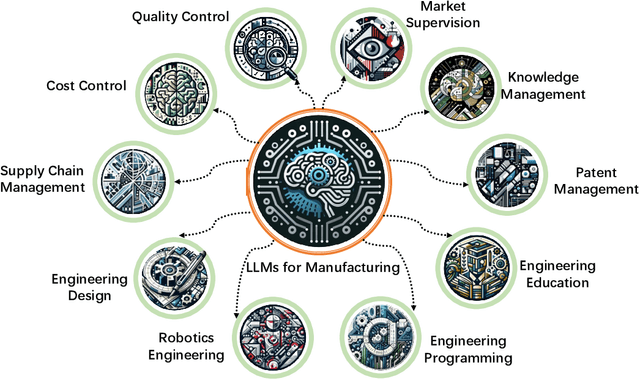

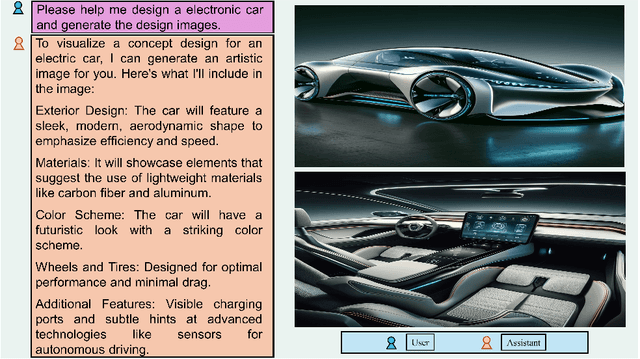

Abstract:The rapid advances in Large Language Models (LLMs) have the potential to transform manufacturing industry, offering new opportunities to optimize processes, improve efficiency, and drive innovation. This paper provides a comprehensive exploration of the integration of LLMs into the manufacturing domain, focusing on their potential to automate and enhance various aspects of manufacturing, from product design and development to quality control, supply chain optimization, and talent management. Through extensive evaluations across multiple manufacturing tasks, we demonstrate the remarkable capabilities of state-of-the-art LLMs, such as GPT-4V, in understanding and executing complex instructions, extracting valuable insights from vast amounts of data, and facilitating knowledge sharing. We also delve into the transformative potential of LLMs in reshaping manufacturing education, automating coding processes, enhancing robot control systems, and enabling the creation of immersive, data-rich virtual environments through the industrial metaverse. By highlighting the practical applications and emerging use cases of LLMs in manufacturing, this paper aims to provide a valuable resource for professionals, researchers, and decision-makers seeking to harness the power of these technologies to address real-world challenges, drive operational excellence, and unlock sustainable growth in an increasingly competitive landscape.
Evaluation of OpenAI o1: Opportunities and Challenges of AGI
Sep 27, 2024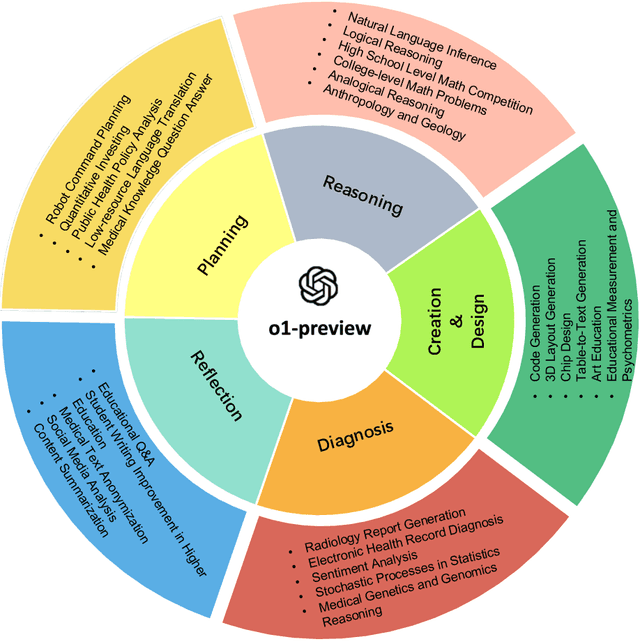
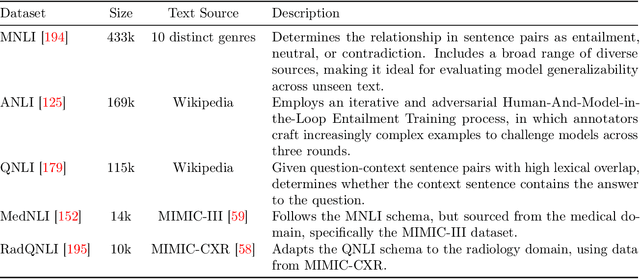
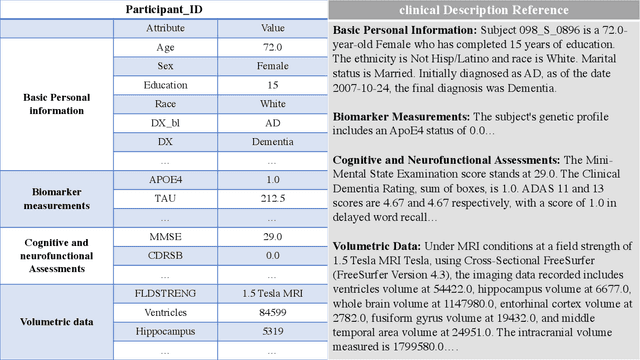

Abstract:This comprehensive study evaluates the performance of OpenAI's o1-preview large language model across a diverse array of complex reasoning tasks, spanning multiple domains, including computer science, mathematics, natural sciences, medicine, linguistics, and social sciences. Through rigorous testing, o1-preview demonstrated remarkable capabilities, often achieving human-level or superior performance in areas ranging from coding challenges to scientific reasoning and from language processing to creative problem-solving. Key findings include: -83.3% success rate in solving complex competitive programming problems, surpassing many human experts. -Superior ability in generating coherent and accurate radiology reports, outperforming other evaluated models. -100% accuracy in high school-level mathematical reasoning tasks, providing detailed step-by-step solutions. -Advanced natural language inference capabilities across general and specialized domains like medicine. -Impressive performance in chip design tasks, outperforming specialized models in areas such as EDA script generation and bug analysis. -Remarkable proficiency in anthropology and geology, demonstrating deep understanding and reasoning in these specialized fields. -Strong capabilities in quantitative investing. O1 has comprehensive financial knowledge and statistical modeling skills. -Effective performance in social media analysis, including sentiment analysis and emotion recognition. The model excelled particularly in tasks requiring intricate reasoning and knowledge integration across various fields. While some limitations were observed, including occasional errors on simpler problems and challenges with certain highly specialized concepts, the overall results indicate significant progress towards artificial general intelligence.
Assessing Large Language Models in Mechanical Engineering Education: A Study on Mechanics-Focused Conceptual Understanding
Jan 13, 2024Abstract:This study is a pioneering endeavor to investigate the capabilities of Large Language Models (LLMs) in addressing conceptual questions within the domain of mechanical engineering with a focus on mechanics. Our examination involves a manually crafted exam encompassing 126 multiple-choice questions, spanning various aspects of mechanics courses, including Fluid Mechanics, Mechanical Vibration, Engineering Statics and Dynamics, Mechanics of Materials, Theory of Elasticity, and Continuum Mechanics. Three LLMs, including ChatGPT (GPT-3.5), ChatGPT (GPT-4), and Claude (Claude-2.1), were subjected to evaluation against engineering faculties and students with or without mechanical engineering background. The findings reveal GPT-4's superior performance over the other two LLMs and human cohorts in answering questions across various mechanics topics, except for Continuum Mechanics. This signals the potential future improvements for GPT models in handling symbolic calculations and tensor analyses. The performances of LLMs were all significantly improved with explanations prompted prior to direct responses, underscoring the crucial role of prompt engineering. Interestingly, GPT-3.5 demonstrates improved performance with prompts covering a broader domain, while GPT-4 excels with prompts focusing on specific subjects. Finally, GPT-4 exhibits notable advancements in mitigating input bias, as evidenced by guessing preferences for humans. This study unveils the substantial potential of LLMs as highly knowledgeable assistants in both mechanical pedagogy and scientific research.
Exploring hyperelastic material model discovery for human brain cortex: multivariate analysis vs. artificial neural network approaches
Oct 16, 2023Abstract:Traditional computational methods, such as the finite element analysis, have provided valuable insights into uncovering the underlying mechanisms of brain physical behaviors. However, precise predictions of brain physics require effective constitutive models to represent the intricate mechanical properties of brain tissue. In this study, we aimed to identify the most favorable constitutive material model for human brain tissue. To achieve this, we applied artificial neural network and multiple regression methods to a generalization of widely accepted classic models, and compared the results obtained from these two approaches. To evaluate the applicability and efficacy of the model, all setups were kept consistent across both methods, except for the approach to prevent potential overfitting. Our results demonstrate that artificial neural networks are capable of automatically identifying accurate constitutive models from given admissible estimators. Nonetheless, the five-term and two-term neural network models trained under single-mode and multi-mode loading scenarios, were found to be suboptimal and could be further simplified into two-term and single-term, respectively, with higher accuracy using multiple regression. Our findings highlight the importance of hyperparameters for the artificial neural network and emphasize the necessity for detailed cross-validations of regularization parameters to ensure optimal selection at a global level in the development of material constitutive models. This study validates the applicability and accuracy of artificial neural network to automatically discover constitutive material models with proper regularization as well as the benefits in model simplification without compromising accuracy for traditional multivariable regression.
Towards Artificial General Intelligence (AGI) in the Internet of Things (IoT): Opportunities and Challenges
Sep 14, 2023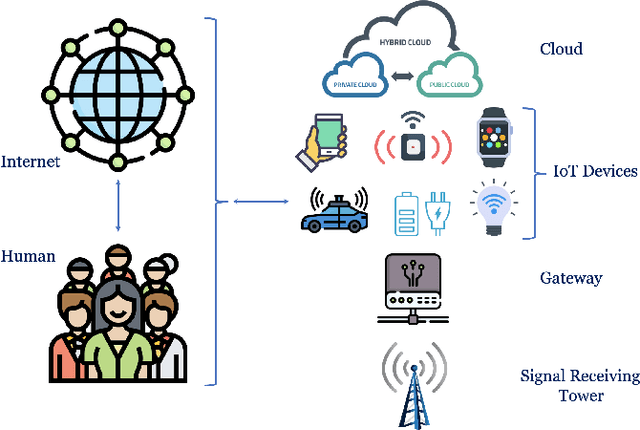
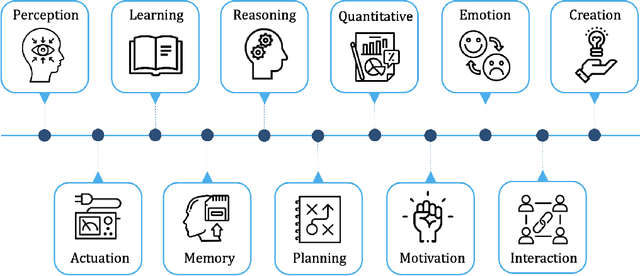
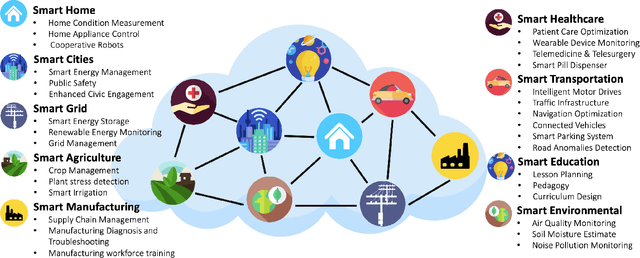
Abstract:Artificial General Intelligence (AGI), possessing the capacity to comprehend, learn, and execute tasks with human cognitive abilities, engenders significant anticipation and intrigue across scientific, commercial, and societal arenas. This fascination extends particularly to the Internet of Things (IoT), a landscape characterized by the interconnection of countless devices, sensors, and systems, collectively gathering and sharing data to enable intelligent decision-making and automation. This research embarks on an exploration of the opportunities and challenges towards achieving AGI in the context of the IoT. Specifically, it starts by outlining the fundamental principles of IoT and the critical role of Artificial Intelligence (AI) in IoT systems. Subsequently, it delves into AGI fundamentals, culminating in the formulation of a conceptual framework for AGI's seamless integration within IoT. The application spectrum for AGI-infused IoT is broad, encompassing domains ranging from smart grids, residential environments, manufacturing, and transportation to environmental monitoring, agriculture, healthcare, and education. However, adapting AGI to resource-constrained IoT settings necessitates dedicated research efforts. Furthermore, the paper addresses constraints imposed by limited computing resources, intricacies associated with large-scale IoT communication, as well as the critical concerns pertaining to security and privacy.
AGI for Agriculture
Apr 12, 2023Abstract:Artificial General Intelligence (AGI) is poised to revolutionize a variety of sectors, including healthcare, finance, transportation, and education. Within healthcare, AGI is being utilized to analyze clinical medical notes, recognize patterns in patient data, and aid in patient management. Agriculture is another critical sector that impacts the lives of individuals worldwide. It serves as a foundation for providing food, fiber, and fuel, yet faces several challenges, such as climate change, soil degradation, water scarcity, and food security. AGI has the potential to tackle these issues by enhancing crop yields, reducing waste, and promoting sustainable farming practices. It can also help farmers make informed decisions by leveraging real-time data, leading to more efficient and effective farm management. This paper delves into the potential future applications of AGI in agriculture, such as agriculture image processing, natural language processing (NLP), robotics, knowledge graphs, and infrastructure, and their impact on precision livestock and precision crops. By leveraging the power of AGI, these emerging technologies can provide farmers with actionable insights, allowing for optimized decision-making and increased productivity. The transformative potential of AGI in agriculture is vast, and this paper aims to highlight its potential to revolutionize the industry.
 Add to Chrome
Add to Chrome Add to Firefox
Add to Firefox Add to Edge
Add to Edge